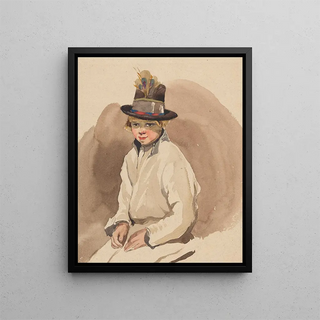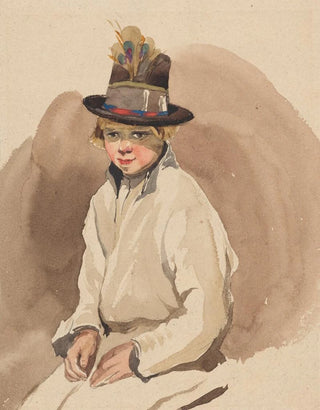Art print | Study of a village boy - Piotr Michałowski


View from behind

Frame (optional)
Piotr Michałowski – Captivating Introduction
In the vast panorama of art history, certain works manage to capture the very essence of humanity, transcending eras and cultures. "Study of a Village Boy - Piotr Michałowski" is one of those creations that, through its apparent simplicity, evokes deep and universal emotions. This piece, highlighting the beauty of juvenile innocence, transports us to a world where every glance and gesture tells a story. Through the depiction of a young village boy, Michałowski invites us to reflect on rural life, dreams, and children's aspirations, immersing us in a universe filled with nostalgia.
Style and uniqueness of the work
Michałowski's work stands out for its ability to combine realism and sensitivity. In "Study of a Village Boy," the painter manages to capture the very essence of his subject with remarkable finesse. The boy's facial features, carefully detailed, evoke a depth of soul that transcends a simple portrait. The light, skillfully orchestrated, plays on the contours of the face and highlights the nuances of expression. Every brushstroke seems to tell a story, and the overall atmosphere of the piece is both gentle and melancholic. The color palette, dominated by warm and earthy tones, reinforces this feeling of authenticity and closeness to nature, reminiscent of Poland's bucolic landscapes.
The artist and his influence
Piotr Michałowski, an emblematic figure of the 19th century, is often regarded as one of the masters of Polish realism. His career, although marked by various influences, always leaned toward a faithful representation of daily life and its inhabitants. Michałowski was able to capture the spirit of his time while remaining deeply rooted in his cultural origins. His work bears witness to a keen sensitivity to social realities and the struggles of the working classes. By exploring themes such as childhood, rural life, and the human condition, he paved the way for a new way of seeing and representing the world. "Study of a village boy"

Matte finish

View from behind

Frame (optional)
Piotr Michałowski – Captivating Introduction
In the vast panorama of art history, certain works manage to capture the very essence of humanity, transcending eras and cultures. "Study of a Village Boy - Piotr Michałowski" is one of those creations that, through its apparent simplicity, evokes deep and universal emotions. This piece, highlighting the beauty of juvenile innocence, transports us to a world where every glance and gesture tells a story. Through the depiction of a young village boy, Michałowski invites us to reflect on rural life, dreams, and children's aspirations, immersing us in a universe filled with nostalgia.
Style and uniqueness of the work
Michałowski's work stands out for its ability to combine realism and sensitivity. In "Study of a Village Boy," the painter manages to capture the very essence of his subject with remarkable finesse. The boy's facial features, carefully detailed, evoke a depth of soul that transcends a simple portrait. The light, skillfully orchestrated, plays on the contours of the face and highlights the nuances of expression. Every brushstroke seems to tell a story, and the overall atmosphere of the piece is both gentle and melancholic. The color palette, dominated by warm and earthy tones, reinforces this feeling of authenticity and closeness to nature, reminiscent of Poland's bucolic landscapes.
The artist and his influence
Piotr Michałowski, an emblematic figure of the 19th century, is often regarded as one of the masters of Polish realism. His career, although marked by various influences, always leaned toward a faithful representation of daily life and its inhabitants. Michałowski was able to capture the spirit of his time while remaining deeply rooted in his cultural origins. His work bears witness to a keen sensitivity to social realities and the struggles of the working classes. By exploring themes such as childhood, rural life, and the human condition, he paved the way for a new way of seeing and representing the world. "Study of a village boy"






